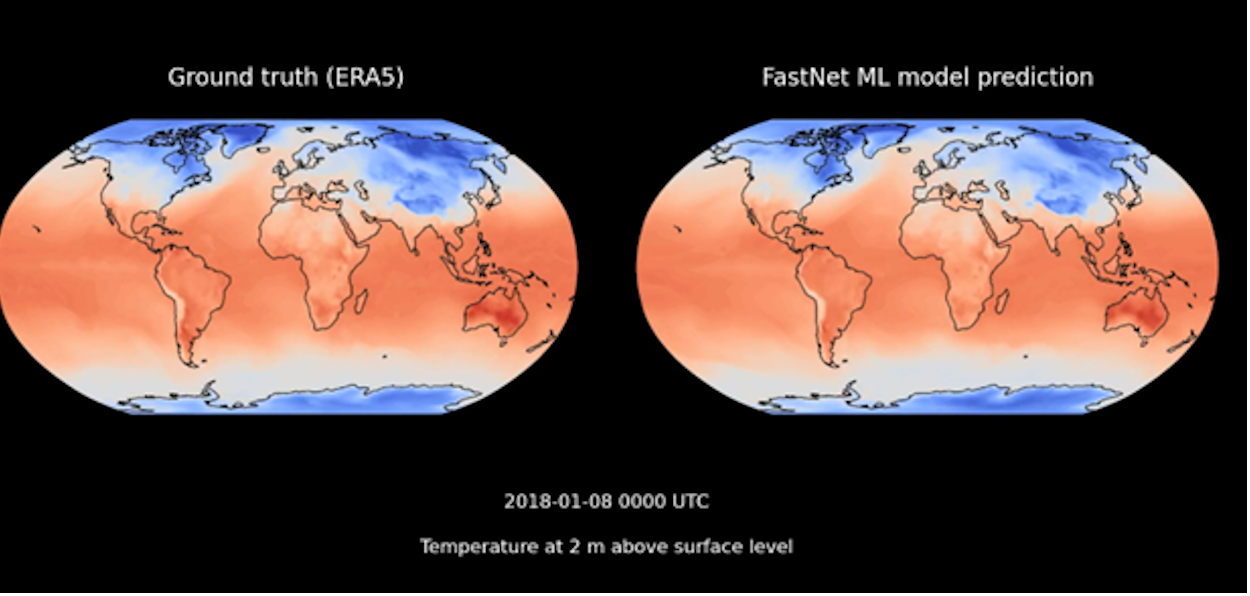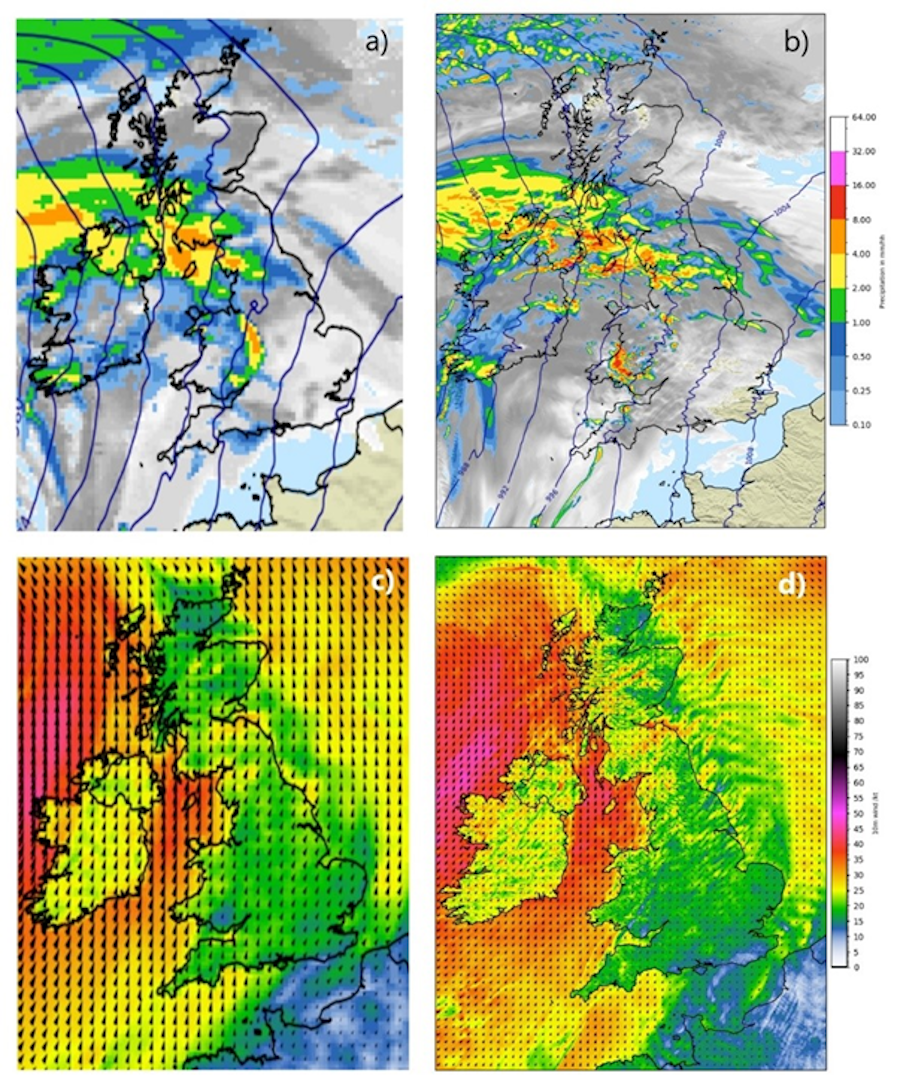Reporting on progress of the Met Office and Alan Turing Institute AI for Numerical Weather Prediction project.
The UK’s weather is notoriously changeable, prompting everything from casual conversation amongst friends to vital decision-making by Government and industry that affects our lives and livelihoods.

Behind the scenes, there is a paradigm shift underway in how we’ll get our daily dose of meteorological information. Artificial intelligence (AI), and more precisely machine learning (ML), is making significant strides in weather prediction, and the UK is at the forefront of this exciting development.
A powerful partnership
A key factor in this progress is the collaboration between the Met Office and the Alan Turing Institute which is helping maintain the UK’s position at the cutting-edge of weather prediction and deploying AI for public good.
The benefits are mutual. Met Office experts have been able to provide crucial training in meteorology and the metrics used to evaluate weather models, while researchers from the Turing have shared their expertise in AI model design and optimisations for scaling-up on cloud platforms.
This partnership has galvanised a new cross-disciplinary team and the exchange of knowledge and skills is accelerating innovation and driving forward the field of weather prediction.
Progress report
So, what have we achieved so far? It’s early days but the results are already promising.
We have developed a machine learning model for weather prediction: “FastNet”, showcasing the potential of this technology to visualise complex weather patterns on a planetary scale.
FastNet, and other AI models like it, represent the next step in the evolution of weather prediction, showing the UK’s commitment to embrace new technologies to remain at the cutting-edge of weather forecasting.
We’re really pleased to see that for some metrics the FastNet model’s performance is comparable to that of the Met Office’s Global Numerical Weather Prediction (NWP) system, an international gold standard in weather forecasting
This is a significant milestone, demonstrating that AI is not just a theoretical concept but a practical tool with the potential to match and even exceed the capabilities of traditional methods. Drawing together AI and traditional physics-based models for weather prediction offers the chance to magnify the strengths of both approaches with models that are fast, accurate, explainable and trustworthy.

A frame from an animation comparing ERA5 (a reanalysis which uses a blend of observations and numerical weather prediction model to produce the best estimate of historical reality) with a prediction from the FastNet machine learning model.
Behind the scenes, a large-scale effort is underway to build a robust data infrastructure that can seamlessly integrate multiple data sources into the AI model. This may not be the most glamorous aspect of the project, but it’s a critical step laying the foundations for continued sustainable development and ensuring that the AI model has access to the most comprehensive and up-to-date information possible.
The word FastNet will be familiar to many as one of the 31 sea areas covered by the Shipping Forecast: a nod to the Met Office’s founder, Vice-Admiral Robert FitzRoy, the first professional weather forecaster, who established the Shipping Forecast.
The future of UK weather forecasting
The ultimate goal of this collaboration is to operationalise the FastNet model so that the Met Office can use the optimal blend of physics-based and ML-based modelling for UK weather prediction. This means that AI could be used alongside physics-based models and play an important role in delivering the daily forecasts that we all rely on. We believe that using AI alongside physics-based numerical models provides the most robust way forward in a changing climate.
The next few months should deliver some important advances in FastNet. Building on initial success with FastNet in global predictions, the partnership will next develop high-resolution regional forecasts for the UK using AI methods.
By ingesting past UK weather forecasts into the FastNet training process, we will further train and refine it to produce detailed regional UK weather forecasts for potential operational use.
For example, this will include:
- The use of multi-resolution input data Traditional weather and climate models often operate close to the limits of the available computational resources, pushing supercomputers to the max, and so compromises need to be made: either reducing some of the complexity associated with the equations for physical processes, or by reducing the spatial and temporal resolution. Global weather models are designed to maximise spatial coverage, but some important small-scale physical processes may not be well represented, notably, convective processes and orographic processes (hills and mountains) that are nevertheless important drivers of localised, high-impact weather events. Limited-area models such as the Met Office’s UK weather model which uses a 1.5km grid is capable of resolving many of these important processes (see image below) but are too expensive to run over a larger area (for example, over the whole of Europe). AI models, such as FastNet now offer the possibility of combining the benefits of large-scale global NWP and high-resolution limited area models within the same model.
- Representing uncertainty through the use of ensembles
The Met Office aims to migrate weather forecasts to ensemble mode, where multiple possible future realities are produced to create an ensemble of outcomes that allows us to assess the range of impending weather. AI is particularly attractive in this context as it offers the possibility of producing vast numbers of possible forecasts with relatively little computational cost – a potential major benefit of AI for weather forecasting. Together the Alan Turing Institute and Met Office will explore how we can produce rapid, cost effective and optimised ensemble weather forecasts. The ensemble produced needs to accurately represent the real weather by being skilful and reliable; so that when we say there is a 90% chance of rain, it really does rain 9 times in 10!

Comparison of output from the Met Office’s Global Model (left) and UKV (right) for precipitation (top) and 10m wind speed (bottom) during Storm Kathleen on the 6 April 2024.
The high-resolution 1.5km grid-spacing used in the UKV model can capture high-intensity convective events (b) and the influence of small-scale topographic features including abrupt mountains and coastlines (b and d), whereas the model with the coarser grid (a and c) cannot thereby limiting its effectiveness to inform detailed mitigation plans for industries including wind generation and agriculture.
Looking to the future, we do not anticipate the need for well-established physics-based simulation approaches to end any time soon.
Instead, we envisage the approaches running alongside and complementing one another maximising their combined strengths to provide accurate, fast, reliable, and trustworthy forecasts for the UK.
For example, physics-based models provide the critical physical-process based insight needed to understand performance and build trust in weather prediction. They are also important when considering events that are outside the data that has been used to train AI models, and they provide the training data used to create AI models (new, recalibrated datasets will be needed as our climate changes).
Complementing this, AI models are accurate, skilful and astonishingly fast (in some cases, tens of thousands of times faster than traditional methods). This speed delivers numerous benefits including more timely, accurate weather prediction at a significantly lower computation cost.
A bright forecast
The potential of AI in weather prediction is immense. By harnessing the power of data science and machine learning, we’re on the path to a future that draws together the strengths of both physics-based and data-driven modelling so that weather forecasts are faster, more accurate, detailed, and personalised than ever before.
The collaboration between the Met Office and the Alan Turing Institute is paving the way for this future, one forecast at a time.


